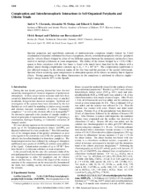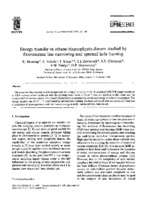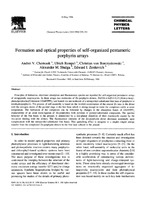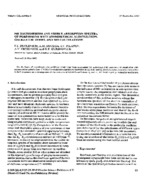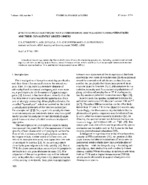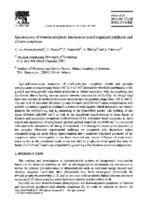Browsing by Author "Chernook, A. V."
Now showing items 1-6 of 6
-
Complexation and interchromophoric interactions in self-organized porphyrin and chlorin triads
Chernook, A. V.; Shulga, A. M.; Zenkevich, E. I.; Rempel, U.; Borczyskowski, C. von (1996)Spectral properties and equilibrium constants of multimolecular complexes (triads) formed by 2-fold coordination of dipyridyl-substituted free bases of porphyrin, chlorin, or tetrahydroporphyrin with Zn-porphyrin and Zn-chlorin dimers bridged by either of two different spacers between the monomeric entities have been studied in methylcyclohexane at room temperature. The ability ...2017-05-18 -
Energy transfer in ethane-bisporphyrins studied by fluorescence line narrowing and spectral hole burning
Mauring, K.; Suisalu, A.; Kikas, J.; Zenkevich, E. I.; Chernook, A. V.; Shulga, A. M.; Gurinovich, G. P. (1995)The quasi-line fluorescence excitation spectrum of 1,2-bis (2,3,7,8,12,13,17,18-octaethyl-21H,23 H-porphino) ethane at 4.8 K consists of two subbands with the splitting mean value of 51cm⁻¹, that are ascribed to the donor and the acceptor half of the homodimer. The donor's fluorescence is quenched by an efficient energy transfer to the acceptor. The energy transfer rate of 10¹¹ ...2017-05-18 -
Formation and optical properties of self-organized pentameric porphyrin arrays
Chernook, A. V.; Rempel, U.; Borczyskowski, C. von; Zenkevich, E. I.; Shulga, A. (1996)Principles of formation, electronic absorption and fluorescence spectra are reported for self-organized pentameric arrays of tetrapyrrolic macrocycles. In these arrays two molecules of Zn-porphyrin dimers, Zn(II)l,4-bis[5-(10,15,20-tri-p-hexylphenylporphyrinyl)]-benzene ((ZnHTPP)₂) are bound via one molecule of a tetrapyridyl-substituted free base of porphyrin or tetrahydroporphyrin. ...2017-05-25 -
NH-tautomerism and visible absorption spectra of porphyrins with nonsymmetrical substitution: oscillator model and mo calculations
Zenkevich, E. I.; Shulga, A. M.; Filatov, I. V.; Chernook, A. V.; Gurinovich, G. P. (1985)On the basis or experiments Ihe oscillator model has been established for individual NH tautomers or porphyrins with asymmetrical substitution. CNDO/2 calculations explain the inversion of Q ₓ (O.O) and Q y (O.O) electronic transition intensities in NH tautomers as a consequence of the inversion of LUMO coefficients c₁ and c₂ for fixed x and y molecular oscillators.2017-05-18 -
Spectral Рeculiarities of NH-Tautomerism in Isocycle-Containing Porphyrins and their Covalently Linked Dimers
Zenkevich, E. I.; Shulga, A. M.; Chernook, A. V.; Gurinovich, G. P. (1984)It has been found experimentally that a whole class of isocycle-containing porphyrins, including synthetic and natural objects and their covalently linked dimers, shows NH-tautomerism which manifests itself in isotropic solutions in normal electronic spectra both at 77 K and higher temperatures (up to 500 K).2017-05-18 -
Spectroscopy of interchromophoric interactions in self-organized porphyrin and chlorin complexes
Zenkevich, E. I.; Shulga, A. M.; Chernook, A. V.; Rempel, U.; Borczyskowski, C. von (1995)Spectral-luminescent properties of multimolecular complexes (triads and pentads, complexation constants range from 5∙10⁶ to 5∙10⁷ M⁻¹) formed by two-fold coordination of dipyridyl and tetra-pyridyl substituted porphyrin or related molecules with Zn-porphyrin and Zn-chlorin dimers having various spacers between macrocycles (-CH₂-CH₂- or phenyl ring) have been studied in methylcyclohexane ...2017-05-18

